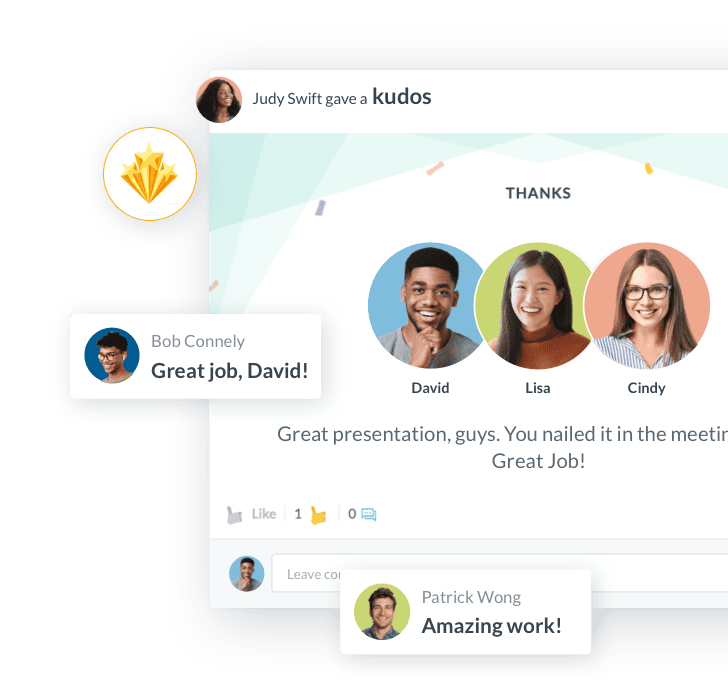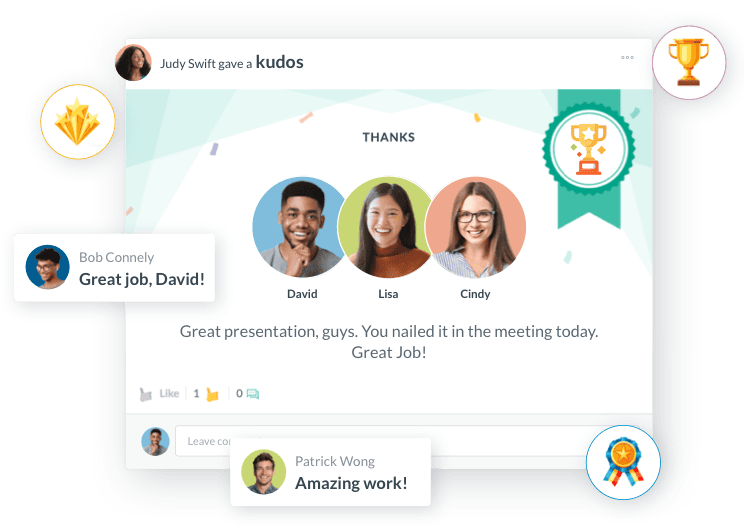20 Employee Engagement Statistics You Need to Know
.png)
- Only 36% of Employees Are Engaged
- Engaged Workforce Increases Profitability by 21%
- Employee Disengagement Costs $450-550 Billion
- 38% of Remote Employees Feel Exhausted
- 85% of Employees Are Motivated With Effective Communications
- 16% of Companies Use Technology for Employee Monitoring
- Over 4x Revenue Growth for Companies with a Thriving Culture
- Recognition Is #1 Motivator for 37% of Employees
- Employment Career Advancement Opportunities Satisfy Only 29%
- 33% of Employees Leave Their Jobs for New Challenges
- Employee engagement surveys are important to 58% of employees
- 61% of employees report complete burnout at jobs
- 71% of Executives Verify That Employee Engagement is a Huge Contributor
- Recognition is Preferred Among 37% of Employees
- Wellness Programs Decrease Employee Absenteeism by 25%
- Increased Engagement Bring 81% decrease in Employee Absenteeism
- 1 in 3 Employees Quit Because of Boredom
- Connected Employees Are 68% Less Likely to Feel Burned Out
- Remote Workers Have 13.5% Higher Productivity Levels
- Older Workers Show More Engagement
- Take Employee Engagement to the Next Level
- ...More Interesting Statistics
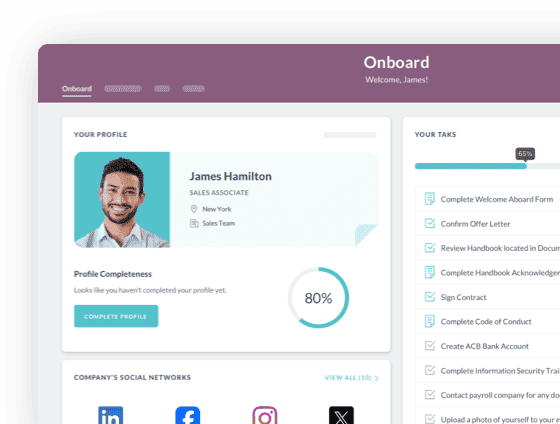
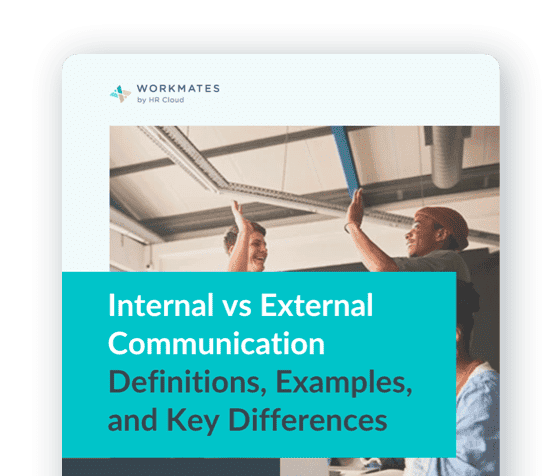
 Cut onboarding time
by 60%—here's the
Ultimate Checklist
that helped do it.
Cut onboarding time
by 60%—here's the
Ultimate Checklist
that helped do it.
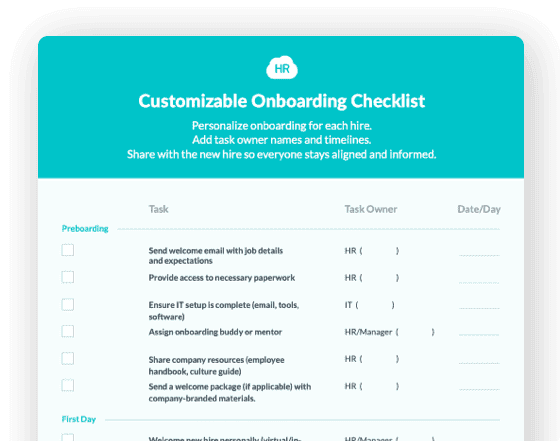
To effectively measure employee engagement and understand the current state of workplace satisfaction, it's crucial to examine key employee engagement stats. These engagement stats provide valuable insights into how organizations can improve their strategies and boost productivity. In this article, let's explore some essential employee engagement data that highlights the importance of fostering a motivated and committed workforce.
High employee engagement leads to higher productivity, higher job satisfaction, more sales, and higher revenue. When your engaged workers are actively involved in the workplace, they feel happier and ready to go above and beyond to achieve your company’s goals. Recent employee engagement research highlights the critical importance of fostering a motivated and committed workforce, especially as we look towards global employee engagement trends in 2024. The latest employee engagement report emphasizes the need for organizations to prioritize engagement strategies for future success.
Now the question is: Are you doing everything you can to engage your employees and maximize their potential?
It is interesting to note that a little above 20% of employees are engaged at work. Although some researchers have argued with this stance, the numbers are relatively between 30 percent to 40 percent of not engaged employees, indicating a significant problem with poor employee engagement across industries.
The interesting employee engagement statistics below should motivate you to focus more on employee engagement and nudge you in the right direction. Let’s dive into these employee engagement trends and statistics, which can provide valuable insights for leadership strategies and improving workplace morale. 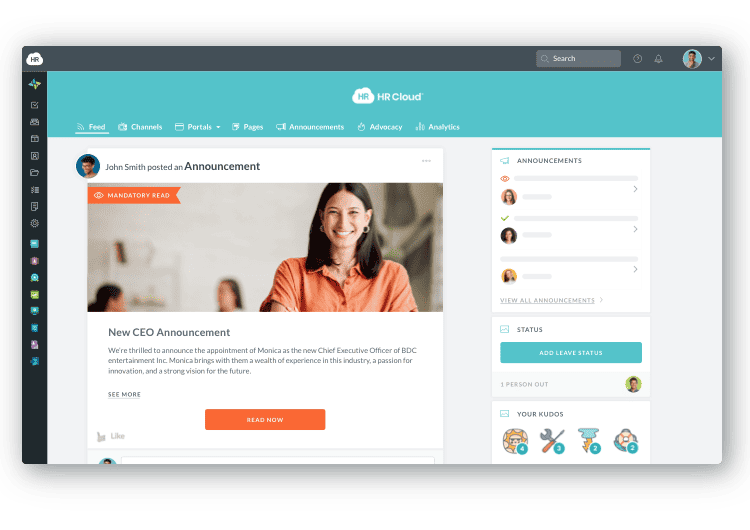
Only 36% of Employees Are Engaged in the Workplace
According to the latest Gallup employee engagement survey, 51% of employees are disengaged in the workplace, while 13% are actively disengaged. Actively disengaged means feeling miserable at work and spreading negativity to their colleagues. This stark contrast between engaged vs disengaged employees highlights the need for improved engagement strategies and a focus on creating a positive work environment.
While 36% of engaged workers is a rather low percentage, it’s the highest since Gallup started measuring employee engagement back in 2000. The number of actively disengaged employees is the lowest since 2000.
In 2017, 85% of employees were not engaged at work, which was a years-long trend. In 2019, the percentage dropped by 10%, meaning that 35% of workers were engaged at the time.
Although employee engagement levels are barely higher now, it’s a surprise that they haven’t dropped due to the pandemic. It shows that many companies have clearly been doing an excellent job of improving employee engagement strategies, which is crucial for maintaining employee productivity and reducing productivity loss. These trends underscore the importance of workforce analytics in understanding and improving engagement levels.
A Highly Engaged Workforce Increases Profitability by 21%
Another Gallup’s report on employee engagement shows that companies with actively engaged employees have 21% higher profitability. They also have 17% higher productivity than companies with a disengaged workforce. This data clearly demonstrates the financial impact of employee engagement on organizational performance and global GDP.
The reasons for this are clear from point number one. Engaged employees lead to a more productive workforce because they are motivated to complete their tasks on time and successfully, even going the extra mile to reach their goals and objectives. They’re better at meeting customers’ needs, which leads to more sales, higher revenues, and improved customer satisfaction.
Engaged employees are also happier, report lower absenteeism, and tend to be more loyal. This positive impact on employee retention can significantly reduce costs associated with hiring and training new staff, ultimately affecting the overall headcount cost for organizations.
Employee Disengagement Costs the U.S. Economy $450-550 Billion Every Year
A study on employee engagement found that companies in the U.S. lose between $450-$550 billion each year due to not engaged employees. This staggering figure underscores the cost of disengaged employees and the impact of poor employee engagement on attrition and productivity, as well as overall economic performance.
That’s partly because of employees’ lack of motivation and a lower sense of responsibility, resulting in lower productivity, errors in work, missed deadlines, poor customer service, and lower profits. This company data shows that a single disengaged employee can cost a company about $3,400 in lost productivity for every $10,000 in salary.
It’s also because many disengaged employees quit their jobs at some point, leaving the employer to reinvest in hiring, onboarding, and training. Many of them even spread negativity through word of mouth, harming an organization’s chances of attracting quality hires and potentially damaging workplace relationships. This highlights the importance of creating a positive work environment that fosters engagement and satisfaction, ultimately reducing employee turnover.
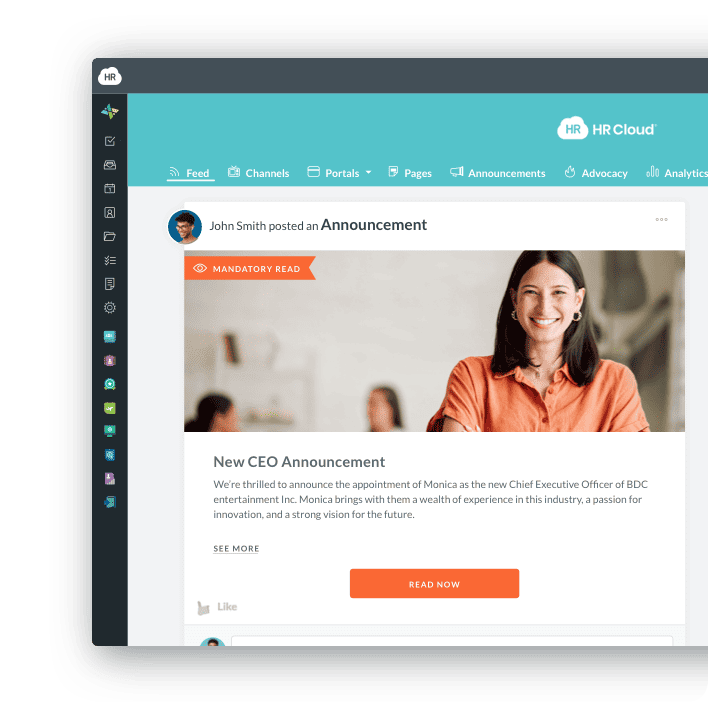

38% of Remote Employees Feel Exhausted After Daily Virtual Meetings
A recent study on the effects of remote work found that most employees show signs of burnout when having virtual meetings every day. This finding highlights the importance of addressing employee well-being and work-life balance in hybrid work settings.
38% of remote employees reported feeling exhausted after daily virtual meetings, while 30% said they felt stressed. These data points to the growing concern of employee burnout in modern work environments and the need to reassess employee expectations in virtual workspaces.
The study was conducted in 2020 when most organizations switched to remote work. To stay connected, some employers held video conferences every day, while others did it weekly.
Staying connected with your remote workforce is essential, especially since they often feel isolated. But frequent virtual meetings could disrupt their workflow and productivity, demotivate them, and stress them out.
They could negatively affect their mental health and job satisfaction, making many of them consider quitting their job. Weekly virtual meetings seem to be a better alternative for maintaining workplace communication without overwhelming employees. This approach can help maintain a healthy work environment while still fostering collaboration.
85% of Employees Are Most Motivated When Internal Communications Are Effective
According to Trade Press Services, effective employee communications motivate 85% of employees to become more engaged in the workplace. This statistic emphasizes the crucial role of workplace communication in fostering employee motivation and engagement.
When managers share company news and other relevant information regularly, employees feel motivated to achieve the mission, vision, and organizational goals. When you raise their awareness of your goals, they will be more engaged with your customers as well.
So, in creating the most effective internal communications, include employee newsletters, press releases, event updates, and other company news, such as milestones and successful projects.
Share information regularly to increase knowledge, consider using internal communication tools to empower teams to collaborate, and build a learning-focused community.
Only 16% of Companies Use Technology to Monitor Employee Engagement
According to a recent Gartner poll, only 16% of companies leverage workplace technology to track employee progress and engagement. They use tools to monitor employee activity and see when they clock in and out, how many hours employees work, when and how many breaks they take, and more.
When you lead a remote or hybrid work environment, tracking employees’ engagement and performance should be one of your top priorities. It can help you enhance your employee engagement strategy and boost your overall business success.
ProProfs Employee Training Software is one of the tools you can utilize to boost knowledge and productivity. Apart from improving your training programs, you can use it to identify workers’ strengths and weaknesses. That will help you train them better, thus motivating them to be more productive.
Companies with a Thriving Corporate Culture Achieve Over 4x Higher Revenue Growth
As you may know, a strong corporate culture can improve team efficiency, which results in a significant improvement in the organization’s financial performance. According to a survey by Hays, 47% of active job seekers want to leave their jobs because of bad company culture.
An extensive research project on corporate culture and performance showed that good company culture could help you increase revenue by more than four times.
The 11-year-long research project found that companies with performance-enhancing cultures grew their revenues by a whopping 682%. Those with a poor company culture managed to increase their revenues by just 166% over 11 years.
So, improving your corporate culture will help you boost workforce engagement, job satisfaction, employee retention, and profitability. It will create a positive and safe work environment where your diverse workforce can thrive and supercharge your business success.
Recognition is the Most Important Motivator for 37% of Employees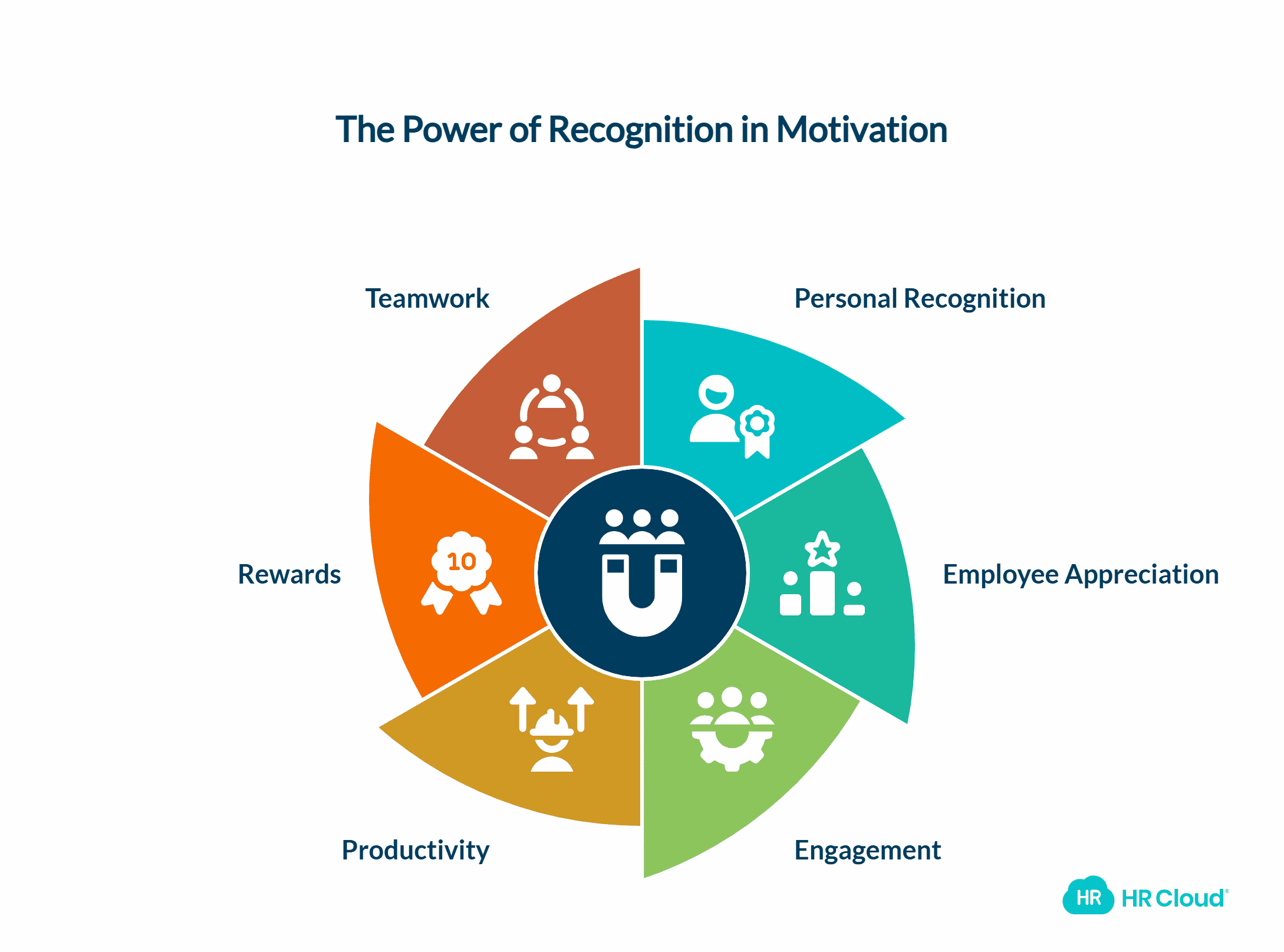
A pat on the back at the right time can go a long way in motivating employees and keeping them engaged during their tenure in an organization.
One study on top performance motivators found that 37% of employees feel most encouraged by personal recognition and employee appreciation.
A recent employee engagement and modern workplace report showed that 84% of highly engaged employees received recognition the last time they went the extra mile at work. Not surprisingly, only 25% of actively disengaged employees were recognized for a job well done.
When you recognize your team members’ good work, whether publicly or privately, you pave the way for their better performance, and when you show you appreciate their efforts, you drive their engagement and productivity.
Employee Recognition Software & Rewards Platform encourages Peer-to-Peer recognition, boosts employee morale, allows employees to feel seen, and also helps create a culture focused on teamwork and excellence.
Your team members will appreciate any kind of gesture of kindness that shows that their accomplishments, no matter how small, didn’t go unnoticed. For instance, paid time off, gift cards, and event tickets are small rewards that can greatly help with improving employee happiness. Monetary incentives are always good motivators, but employees are encouraged by other kinds of recognition as well.
Even the smallest of accomplishments make a difference in reaching your long-term goals, so show your teammates that you value all their contributions.
And, remember, a simple “Thank you” can also go a long way.
Only 29% of Employees Are Satisfied with Available Career Advancement Opportunities
SHRM’s research on the Employee Job Satisfaction and Engagement survey found that only 29% of employees are “very satisfied” with their available career advancement opportunities. 41% marked those opportunities as “very important” when it comes to job satisfaction, engagement, motivation, and employee retention.
The survey also found that 44% of employees are “very satisfied” with opportunities to use their skills and abilities at work.
In an ideal world, these numbers are at the top end of the scale, but you can increase them with the right opportunities for career growth and professional development.
If you want to have engaged teams across departments, boost their expertise, and make your organization more profitable, provide them with the learning opportunities that they seek.
33% of Employees Leave Their Jobs for New Challenges
According to a Korn Ferry survey, 33% of employees jump ship because they feel bored in the workplace and want to find new challenges. They seek new opportunities for professional growth, which motivates them to keep learning and become better at what they do.
That’s why implementing new challenges and variations in day-to-day activities should be one of the top priorities for managers and human resources professionals. Providing employees with opportunities to learn and grow continually is the key to driving employee engagement and retention.
Promotion opportunities are also essential for company growth, as they boost employee experience and help develop skills and competencies.
58% of Employees Wish Their Workplace Conducted Employee Engagement Surveys More Frequently
In a survey that was conducted right after the pandemic, most employees appreciated their say in the workplace. They appreciated when the employers took their feedback, as it made them feel as if they were a part of the community.
In the same survey, more than half of the employees expressed their concerns regarding the minimal acquisition of employee input. 58 percent of employees said they wished their workplaces conducted more employee engagement surveys.
Employees who were surveyed four times each year, instead of once every other year, engaged much more actively at the workplace.
61% of Employees Report Complete Burnout at Jobs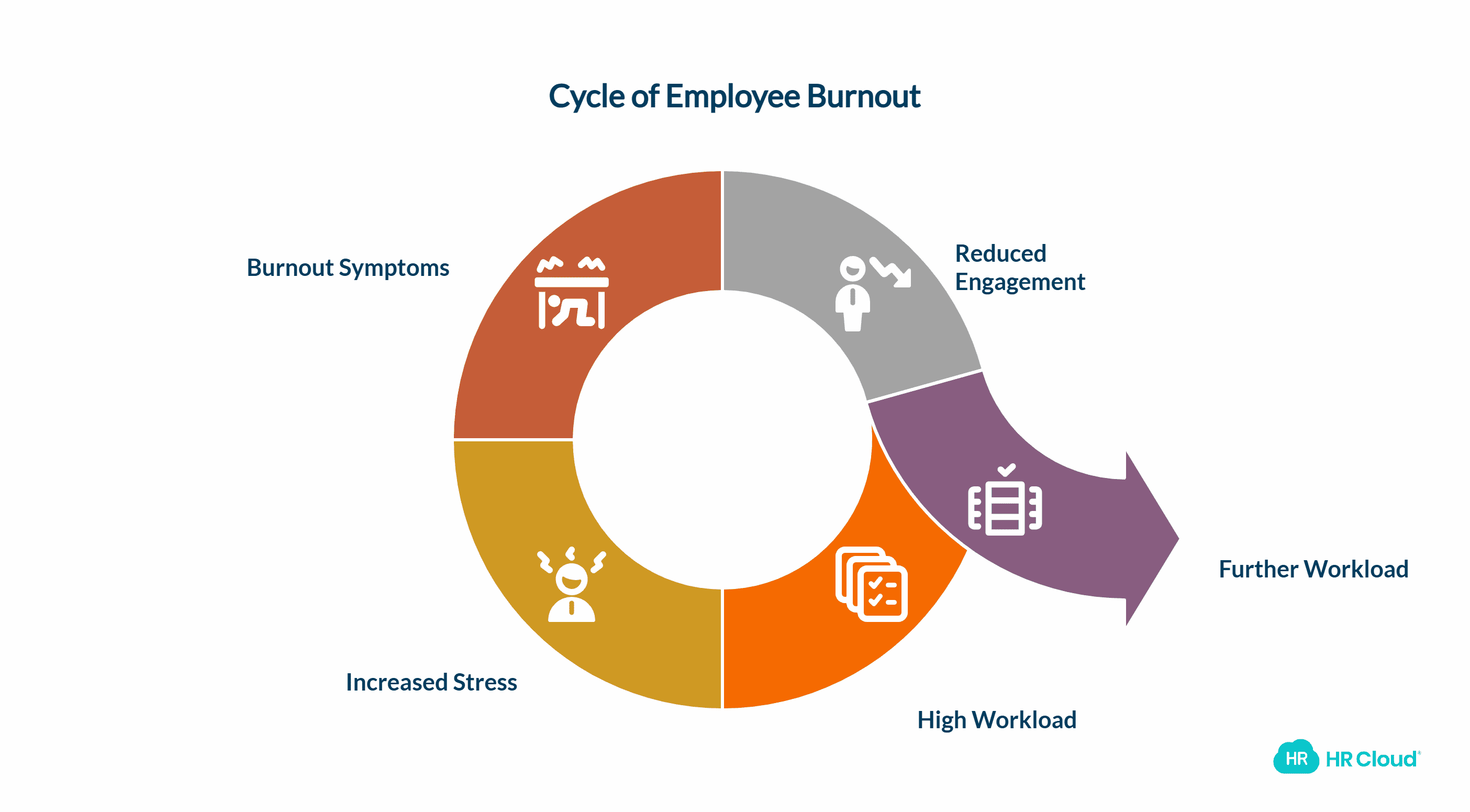
Fostering employee engagement is a solution when employees are burned out. Unfortunately, many companies perceive employee engagement as simply adding more tasks to an already overflowing workload. Instead of fostering genuine connection and collaboration, they pile on additional responsibilities during times designated for team engagement.
Consequently, approximately 61% of employees find themselves grappling with burnout, feeling overwhelmed by the relentless demands placed upon them, affecting their mental health.
This figure is expected to rise even further in 2022, reflecting a concerning trend where employees are stretched thin and struggle to maintain a healthy work-life balance amidst mounting pressures.
71% of Executives Verify That Employee Engagement is a Huge Contributor to Organizational Success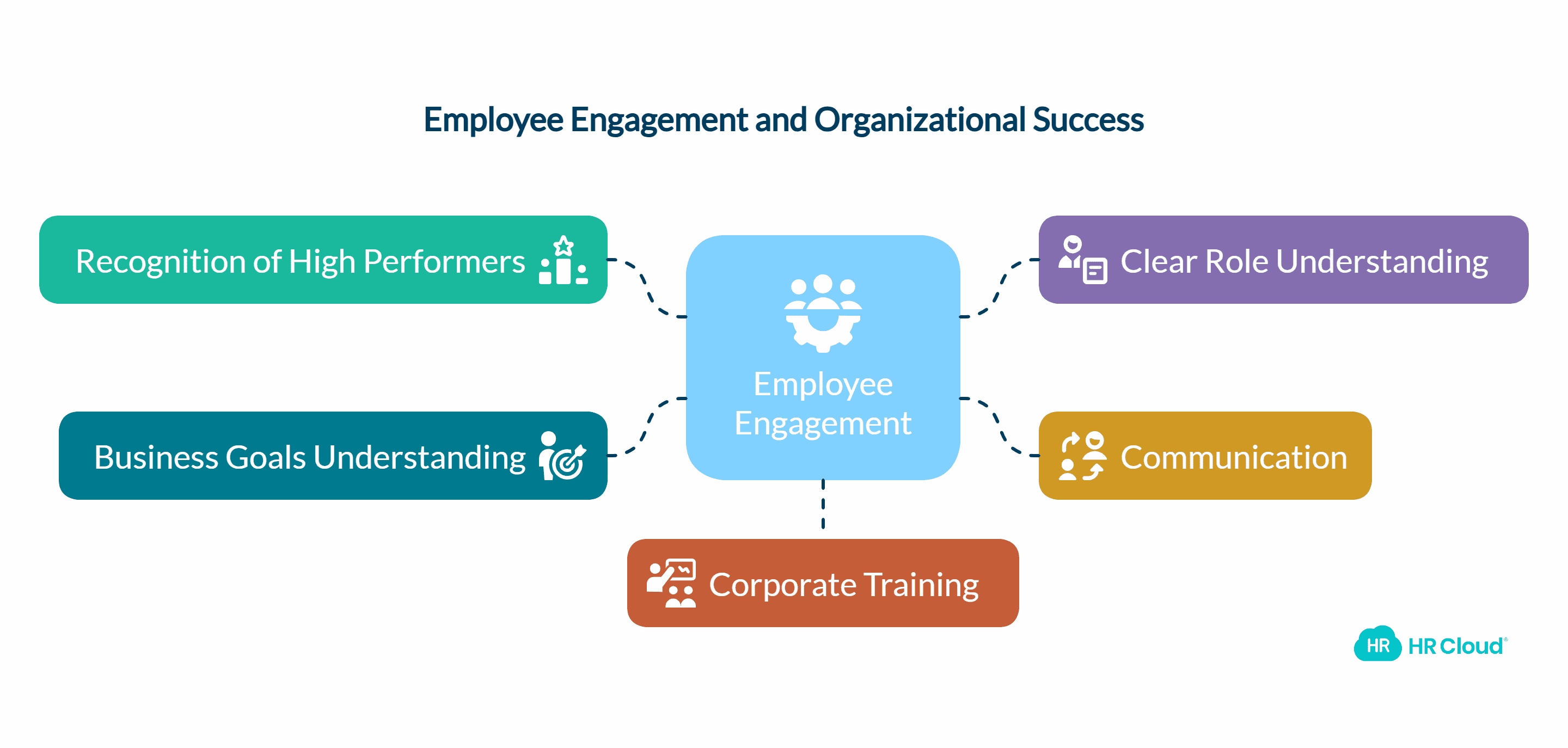
Harvard Business Review conducted a detailed study on employee engagement and released all of its findings in a journal called The Impact of Employee Performance. From this journal, we got to know that 71% of executives believe it's a high level of employee engagement that sets their company up for immense success.
Further breakdown tells us that the biggest employee engagement driver is the recognition of high performers. It is followed by having a clear understanding of their role and contribution to the strategy, communication, understanding of business goals, and corporate training and development of the individuals.
You can use it to direct your employee engagement in the right direction, and once the situation is better, acquire employee testimonials. These will help you verify your implementation strategy. Thus, making room to proceed with the other two metrics that lead to their organizational success includes:
- High level of customer service (80 percent)
- Effective communication (73 percent)
So, that's what you should follow once employee engagement has worked well enough.
Recognition is Preferred Among 37% of Employees
Octanner.com reports that respondents to a study on what would be the most important thing a manager or a company could do that would help the employee become successful suggested recognition.
The study proves that a significant percentage of employees would love to put their all to work for an organization when they are accorded the level of recognition they desire.
A study by the Incentive Research Foundation found that 84% of employees experienced increased motivation upon receiving recognition for their work.
Also, an Officevibe survey revealed that 51% of employees who received consistent recognition are prone to recommending their company as an excellent workplace.
Wellness Programs Decrease Employee Absenteeism by 25%
The research conducted in 2012, which analyzed 42 studies, revealed that participants in workplace health promotion programs had approximately 25% lower medical and absenteeism expenditures than nonparticipants.
Programs like these often include fitness activities, nutrition guidance, stress management, and mental health support. By addressing various aspects of employee wellness, organizations foster a supportive and healthy work environment.
Engaged workers are more likely to collaborate effectively, innovate, and deliver high-quality work, which increases workplace productivity and enhances business performance.
In addition, highly engaged employees are less likely to look elsewhere for work, which leads to higher employee retention rates.
There's an 81% Decrease in Employee Absenteeism with an Increase in Employee Engagement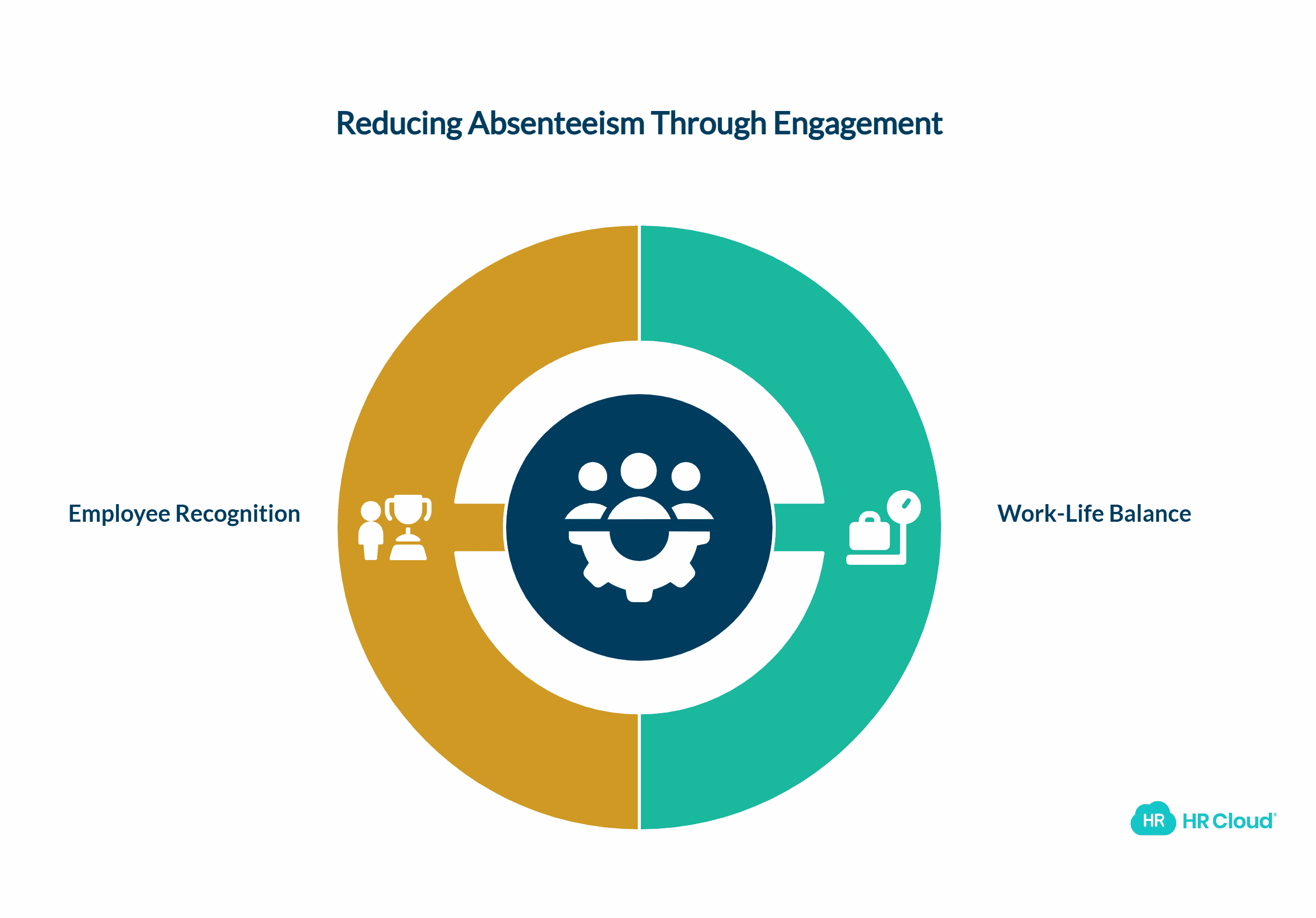
This particular statistic is really shocking. From wages to work culture, the major reason behind employee absenteeism is the lack of engagement. On a positive note, working on this can ensure you have a stable workforce available at all times.
But how? Of course, employee engagement is a vast topic. It's more than keeping your employees happy and content. It's about motivating, assisting, encouraging, and providing direction.
However, you can start with two important areas: work-life balance and employee recognition. The majority of employees won't skip work if there's no compromise on personal life and career. Plus, encouraging them for their efforts serves as a great motivator.
1 in 3 Employees Quit Because of Boredom
According to one survey, the majority of employees change their jobs because of boredom. While it may sound unbelievable, the lack of challenges can significantly exhaust an employee. Doing a task continuously uses the same skills again and again.
Plus, it drains the motivation to work. It even makes them feel as if they aren't able to use their expertise to the full extent. As a result, the task seems like a waste of talent and skill.
Hence, it is crucial to ensure that the employees have sufficient challenges and variation in work. Not only will this keep them engaged, but it will also support employee development and improve competency.
Connected Employees Are 68% Less Likely to Feel Burned Out at Work
A report from Gallup on Empowering Workplace Culture Through Recognition found that 68% of employees who feel connected to their organization’s culture are less likely to feel burned out at work.
Culture is the heartbeat of an organization, shaping its very essence. When organizations articulate and reinforce the values that drive employees to excel daily, progress toward goals accelerates.
A strong culture not only fosters engagement but also provides a roadmap to align that engagement with the organization's objectives and mission, serving as a guiding framework for success.
Remote Workers Have 13.5% Higher Productivity Than Office-Based Employees
While some companies are embracing remote or hybrid work models, not all positions are conducive to full-time remote work. Offering employees flexible work arrangements can enhance talent retention, attract candidates, and distinguish companies in today's competitive labor landscape.
Stanford University conducted a study revealing that remote workers consistently meet and exceed objectives, identify new processes, and contribute to company culture just as much as anyone in a traditional brick-and-mortar setting.
They tend to accomplish, on average, 13.5% higher productivity points compared to their on-site counterparts.
Older Workers Show More Engagement
Another study showed that while older workers may show higher levels of engagement due to stability and experience, younger workers also thrive when valued and offered growth opportunities.
Individual differences drive engagement across age groups, as shown in a study by SHRM where employees under 40 exhibited lower engagement compared to those in their late forties and above. Take Employee Engagement to the Next Level
Improving employee engagement is the key step to business success. When you create a positive work environment where people can grow daily and receive recognition for their efforts, nothing will stand in your way of achieving your goals.
Hopefully, these engagement metrics have inspired you to focus more on engaging your workforce because that means improving your entire organization’s performance. Start implementing the strategies for engaging your employees today, and you’ll boost your company’s profitability before you know it.
More Interesting Statistics
-
33% of employees express being "very satisfied" with paid time off benefit - according to SHRM’s report
-
Employees who take a break every 90 minutes report a 30 percent higher level of focus
-
90% of leaders think an engagement strategy has an impact on business success but barely 25% of them have a strategy - as stated by Muse
-
Gallup's employee engagement database has 70% fewer safety incidents compared with bottom-quartile units.
-
3 in 5 HR leaders believe that the HR function will rapidly become irrelevant if it doesn’t modernize its approach to understanding and planning for the future needs of the workforce - KPMG source
-
According to Unleash, 52% of frontline workers claim they would leave their jobs over tech tools
-
Gallup data states that 95% of people who are thriving at work report being treated with respect all day
-
87% of workers believe their employer should do more to listen to the needs of their workforce - source Oracle
-
Zipia stated that 72% of workers believe work-life balance is a very important factor when choosing a job
-
72% of employees agree that an engaged employee thinks beyond their job title, in the LinkedIn poll ran by Select Software Reviews.
FAQs
-
What is employee engagement and why is it important?
Employee engagement goes beyond job satisfaction, directly impacting workplace productivity, retention, and company culture. Engaged workers are more committed to their roles and the organization's goals, leading to better performance and business outcomes.
-
How does employee engagement affect company profitability?
According to Gallup, companies with engaged employees see 21% higher profitability and 17% higher productivity. This demonstrates the significant financial impact of having an engaged workforce.
-
What are the signs of employee disengagement?
Indicators of disengagement include increased absenteeism, lack of initiative, frequent mistakes, and negative influence on team morale. These signs can help managers identify areas for improvement in their engagement strategies.
-
What are the best strategies to improve employee engagement?
Effective strategies include recognition programs, career development opportunities, wellness programs, implementing internal communication tools, and conducting regular employee surveys. These approaches help create a more engaging work environment.
-
How does employee recognition improve engagement?
37% of employees rank recognition as the top motivator. Recognition programs have been shown to improve retention rates, boost morale, and increase overall employee satisfaction and engagement.
-
Why is internal communication critical to employee engagement?
85% of employees say effective communication makes them more motivated and connected to their work. Good internal communication ensures employees understand company goals and their role in achieving them.
-
What role does remote work play in employee engagement?
Remote workers have shown 13.5% higher productivity, but face challenges like Zoom fatigue. Successful engagement strategies for remote teams include asynchronous updates, limited meetings, and leveraging technology for collaboration.
About Author: Angela White is an ed-tech enthusiast with a passion for writing for the consumer market in the areas of product research and marketing using quizzes and surveys. Having a knack for writing and an editorial mindset, she is an expert researcher at a brand that’s known for creating delightfully smart tools such as ProProfs Quiz Maker.
Keep Reading
45 Boss Day Messages That Actually Mean Something (2026 Guide)
When is Boss Day 2026? Mark your calendar for October 16, 2026 — the annual opportunity
Birthday Wishes for Coworkers: 50+ Messages That Build Workplace Connection
A coworker's birthday isn't just another calendar date—it's a meaningful opportunity to
Embracing Diversity: Recognizing Different Cultures in the Workplace
Workplaces today reflect the incredible diversity of the world around us. People bring
Like What You Hear?
We'd love to chat with you more about how HR Cloud® can support your business's HR needs. Book Your Free Demo

Build a Culture of Recognition. Boost Engagement. Guaranteed.
Workmates empowers employees to stay informed, connected, and appreciated—whether they’re on the front line, in the office, or remote. Recognition drives 12x higher engagement.Trusted by industry leaders in every sector




Cut Onboarding Costs by 60%.
Take the confusion and follow-ups out of onboarding with automated workflows, digital forms, and structured portals—so new hires ramp faster 3X quicker.Trusted by industry leaders in every sector





